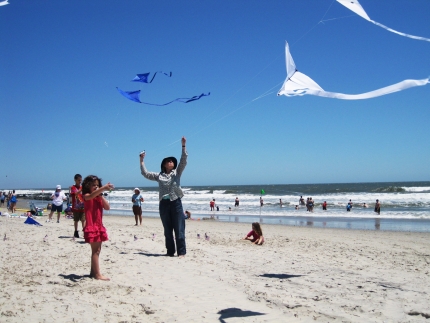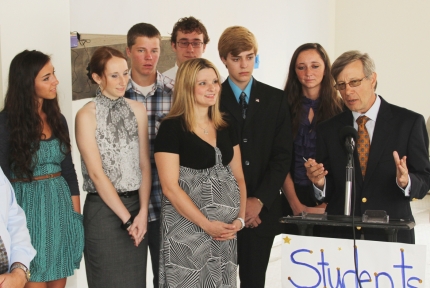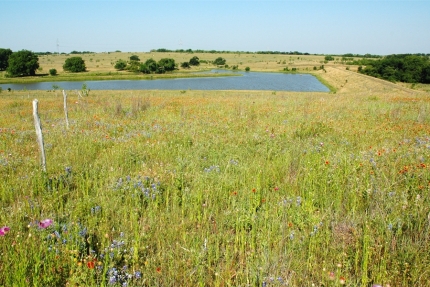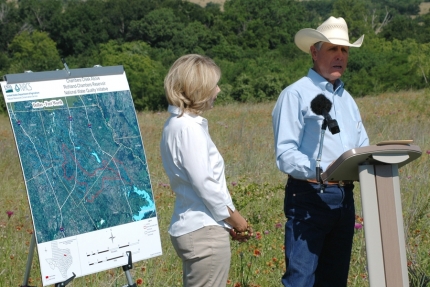Council on Environmental Quality Blog
Advanced Vehicles: Advancing Our Communities
Posted by on June 27, 2012 at 5:58 PM EDTEditor's Note: This blog introduces readers to Jules Toraya, Project Manager at the City of Atlanta's Mayor's Office of Sustainability.
Today at an event held at the White House, the Obama Administration recognized innovators in the auto sector, and the positive impacts the resurgence of the auto industry is having in communities across the country. As the leader of the City of Atlanta's plug-in electric vehicle readiness strategy -- and an officer currently assigned to the Inactive Reserves -- I was honored to be recognized and to engage in a conversation on this topic.
My interest in advanced vehicles and clean energy is tied to my history as a Captain in the U.S. Army. After two tours in Iraq supporting Operation Iraqi Freedom, I became motivated to find ways to reduce petroleum consumption and minimize the need for the Department of Defense to secure America's oil supply chain.
In my last year of active duty, I volunteered for Clean Cities Atlanta and the City of Atlanta's Mayor's Office of Sustainability to help make Atlanta Electric-Vehicle (EV) ready -- and ended up working as a full time administrator on a Department of Energy EV Community Readiness Project with the Center for Transportation and the Environment. Now, I am also coordinating a local public-private partnership, Plug-in Georgia, which is taking a regional approach and working with communities throughout Alabama, Georgia and South Carolina to ease the deployment of EVs. As more plug-in vehicles become available, they are likely to become popular since the Southeast is home to some of the lowest electric utility rates in the country. Atlanta EV infrastructure is building as more plug-in electric vehicles become available. This past Memorial Day in Atlanta, City Council opened Atlanta's first Neighborhood Electric Vehicle Charging Station to the public in honor of those who have been killed in Operations Iraqi Freedom, New Dawn and Enduring Freedom.
Today's event with diverse industry, labor and government leaders reiterated how far we have come in developing advanced vehicles that reduce our country's dependence on foreign oil, and grow jobs in our communities. The Obama Administration's new fuel economy standards, developed in partnership with stakeholders, will encourage even more innovation, and save consumers trillions of dollars at the pump. Mayor Kasim Reed has pledged that the City of Atlanta will become one of the top 10 most sustainable cities in the United States. Supporting advanced vehicles will help us achieve this goal, and keep our communities healthy and strong.
Jules Toraya is Project Manager at the City of Atlanta's Mayor's Office of Sustainability
Learn more about Energy and EnvironmentAnnouncing the Winners of the Youth Sustainability Challenge
Posted by on June 21, 2012 at 9:00 AM EDTRight now, representatives from around the world are gathering at the United Nations Conference on Sustainable Development, or Rio+20, to take part in a global conversation about sustainability and economic growth. The Obama Administration believes that engaging and harnessing the energy and creativity of the world’s youth is critical for long-term sustainability. Innovative ideas and actions often originate from young people around the world, and have the potential to inspire a new generation to help build a more sustainable and prosperous future. Accordingly, the U.S. is making every effort to involve youth as a core part of our sustainability efforts.
That’s why we launched our first ever Youth Sustainability Video Challenge. Our hope was to showcase how youth are already playing an important role in the sustainability conversation. In early May, Nancy Sutley, Chair of the White House Council on Environmental Quality, and Lisa P. Jackson, Administrator of the U.S. Environmental Protection Agency, challenged youth from around the country to tell the world what they are doing in their communities to foster sustainability and help create an America, and a world, built to last.
The results are really quite impressive, and show how innovative young Americans are today. From high school students deploying a micro-grant program, to a young group of engineers creating a solar powered water purification system, the videos showcase a range of creative approaches to sustainability.
Submitted videos were eligible for up to five awards reflecting innovation, contribution to sustainability, communication, and popular choice. After careful review by a panel of Administration officials, the winners are:
- For best overall: “A Generation of Energy: Georgetown Energy”
- For contribution to sustainability: “Every Day Actions, Enduring Results”
- For success in communicating sustainability: “Carmel Green Teen Micro-Grant Program”
- For innovation: “Operation Gulliver International”
- The popular choice (voted by the public on Challenge.gov): “Growth”
Susan Ruffo is Deputy Associate Director for Climate Change Adaptation at the White House Council on Environmental Quality
Learn more about Energy and EnvironmentCelebrating Global Wind Day
Posted by on June 15, 2012 at 4:35 PM EDTEditor's Note: This blog introduces readers to Christine Guhl, Associate Organizing Representative at Sierra Club.
What could be better than a day at the beach flying kites? What if we could harness the power of all that wind to create homegrown clean energy? That’s just what people around the world are asking today, on Global Wind Day. And here at the Jersey Shore, we’re showing that investing in clean, safe energy like offshore wind is important to ensure our economy is built to last.
This Global Wind Day I’ll be joining other Garden State residents and families at local beaches to get wind em-powered with a kite-flying rally in support of offshore wind. I’ve lived in New Jersey my entire life and I want my state to be a leader in the clean energy economy by being one of the first in the U.S. to make offshore wind a reality.
New Jersey has 16,000 MW of offshore wind potential. That’s enough to power more than 4 million homes in our state alone. The U.S. National Renewable Energy Laboratory estimates that the potential for offshore wind power in the U.S. is four times greater than the country's current total generating capacity from all sources.
The U.S. wind industry has already created more than 75,000 jobs and could support as many as 500,000 jobs by 2030. Here in New Jersey alone the wind industry already supports hundreds of jobs. New offshore wind installations would create real jobs for people who need them now.
Wind power’s economic and environmental benefits are worth celebrating. But Global Wind Day is not just about discussing New Jersey’s offshore wind potential. It’s about calling on our leaders to turn that potential into action.
We need strong leadership on the state and federal level to listen to Americans’ call for a clean energy future. President Obama has already recognized that wind power is an important part of the country’s energy mix. It’s up to the rest of our leaders to ensure that wind can live up to its potential.
The U.S. has not yet begun to tap into its offshore wind resources, but we’re looking to change that through our work on events like Global Wind Day. I hope next year we can celebrate Global Wind Day knowing that our homes are being powered with clean, safe, renewable energy from wind.
Christine Guhl is Associate Organizing Representative at Sierra Club
Learn more about Energy and EnvironmentSupporting Appalachian Communities
Posted by on June 15, 2012 at 2:54 PM EDTEditor's Note: This blog introduces readers to Earl F. Gohl, Federal Co-Chair of the Appalachian Regional Commission.
Throughout the Appalachian Region there is an incredible group of folks who get up each day and work to make their communities better places for their kids and grandkids. These folks have a variety of hopes and dreams, skills and talents; they are teachers, entrepreneurs, health care workers and myriad of other occupations and avocations. Meeting them, getting to know them, and seeing their energy, dedication and creativity is incredibly inspiring.
The challenge for the Appalachian Regional Commission (ARC) is to figure out ways to partner with these “spark plugs” to support their work and help them achieve their dreams.
The White House Rural Council provided ARC with a forum to do just this. Through the Rural Council ARC has developed the Livable Communities Initiative, a partnership with the U.S. Environmental Protection Agency (EPA) and the U.S. Department of Agriculture Rural Development (USDA RD) that provides technical assistance to small rural towns to help them develop and implement strategies for making their communities more livable and competitive. ARC has learned that early technical support and advice like this is often the critical piece of the development puzzle that provides the necessary boost to help a community succeed. Seven Appalachian communities will be receiving this Livable Communities technical assistance support.
Recently I had the opportunity to visit with the leaders of three Appalachian communities who requested and were selected to receive this technical assistance. The towns of Uhrichsville in Ohio, and Connellsville and Brownsville in Pennsylvania have all devised ways to take what they already have, whether unused buildings or parking lots, and turn them into community assets.
I thoroughly enjoyed my visit to Brownsville, Pennsylvania, where the proposal was initiated by a group of local high school students who were also recognized by the Jefferson Awards competition in April. It was their creative and entrepreneurial idea to transform a vacant lot into a traditional town square to revitalize and galvanize their downtown. One of the students told the local newspaper, “Brownsville is not what it once was. Our project hopes to bring back community spirit, to be a shot in the arm of adrenaline.” The above photo shows me with the students, and their teacher Kelli Dellarose.
Similar enthusiasm marked the work I saw in Uhrichsville and Connellsville, where a strong network of local partners, public and private, is committed to achieving the community’s vision. In each community, I was met by a large contingent of active and engaged project supporters. As Michael Edwards, executive director of the Connellsville Redevelopment Authority, said during my visit, the technical assistance provided by the ARC-EPA-USDA partnership was advancing a revitalization project on which “many organizations, community volunteers, and city officials have worked diligently.”
Because of the work of the White House Rural Council, those student “sparkplugs” in Brownsville and enthusiastic community partners in Connellsville and Uhrichsville, as well as in communities across Appalachia, have a better opportunity to use local assets to achieve their dreams and create more vibrant local economies. I am looking forward to spending the next few months visiting with these Livable Communities winners and seeing how their visions come to life.
Earl F. Gohl is the Federal Co-Chair of the Appalachian Regional Commission
Learn more about Energy and Environment, RuralA Clear Answer to Clean Water
Posted by on June 7, 2012 at 3:48 PM EDTHow important is water? Well, it’s not a question I have to think too hard about. What I can tell you is that without it, there wouldn’t be any humans or critters roaming the earth.
In the U.S., we use a little more than 400 billion gallons of water a day. According to the UN, in the worldwide picture about one in five people lack access to a clean, improved water source.
At USDA’s Natural Resources Conservation Service (NRCS) we view clean water as a top priority. Every day, our employees work with farmers and ranchers to improve on-farm water management—using a systems approach to avoid, control and trap pollutants.
The type of pollutants we are working to control, through our conservation actions or “practices” are farm waste, fertilizer, sediments, pesticides and herbicides. Our goal is to stop these at or before the edge of a field, so they don’t run into the water. And that’s why we recently created the National Water Quality Initiative.
Through this effort we are focusing on priority watersheds in every state, where on-farm conservation investments have the best chance to improve water quality. To do this, we took an in-depth look at the impaired waterways list and then we asked for input from our local and state partners to pick the watersheds that were ultimately selected as a focal area.
We launched the National Water Quality Initiative with $33 million dedicated for farmers and ranchers, with financial assistance for any size agriculture operation to help reduce the loss of excess nutrients and sediments from their fields. We expect to show how the actions of farmers and ranchers can remove a stream from the impaired list.
When large numbers of farmers take action together in one area, in one watershed, it can make a difference—it can stop an algae bloom or keep bacteria from reaching a drinking water source. And clean water is absolutely critical for the freshwater ecosystems that 44,000 aquatic species call home.
In Texas, ranchers Gary and Sue Price have been working with NRCS and the Navarro Soil and Water Conservation District for over 35 years to implement conservation practices on their ranch which lies in the Trinity River Basin—an area that provides water for over 40 percent of Texans.
The Prices began addressing water quality several years ago when they converted a portion of their cropland to a wetland. Wetlands are the clean water sponges, or kidneys, of the land. They minimize soil erosion and are excellent wildlife habitat. The couple also installed a riparian buffer with native plants. This buffer acts as a filter while creating habitat for both bobwhite quail and Rio Grande turkey.
If you are a farmer, rancher or forest landowner interested in signing up, you can check a map online and see if you are located in a priority area. If you prefer the in-person route, we have USDA service centers in almost every county, and you are always welcome to stop in and complete an application. Applications must be submitted by June 15, 2012 in order to be considered for this fiscal year’s funding opportunity.
Since the White House Rural Council was established last June, the Council has provided a forum for increasing conservation work and creating jobs in rural America. Through the National Water Quality Initiative, we will have measurable progress achieved with support from the Rural Council.
Follow NRCS on Twitter.
Dave White is Chief of the Natural Resources Conservation Service (NRCS)
Learn more about Energy and Environment, RuralGreen Button Momentum
Posted by on June 7, 2012 at 12:33 PM EDT[Editor's Note: This blog has been cross-posted from the Office of Science and Technology Blog.]
To make it easier for business and consumers to save energy and money, we need to make it easier for them to understand how they use energy. That is why the Obama Administration partnered with the utility industry and issued a challenge to them to make it easier for electricity customers to get secure online access to their own household or building energy-use in a consumer- and computer-friendly format, called “Green Button.”
In addition to empowering consumers and business to make informed decisions, Green Button data can fuel new products and services. By putting customers in control of their own energy data, they can choose which private sector tools and services can help them manage or upgrade their own household or building energy performance.
Today, responding to a call by President Obama to help families and businesses take better control of their energy bills, a number of companies announced their commitment to use the Green Button standard in their products. These companies include:
- Autodesk
- C3
- EnerNOC
- Hara
- Johnson Controls Inc.
- Pulse Energy
- U.S. Green Data
These companies join a growing universe of companies that have already announced they are developing applications or services for business, consumers, and utilities using the Green Button industry standard.
That means over 31 million households and businesses will be able to use web and smartphone apps to pick the best rate plan for them; take advantage of customized energy efficiency tips; utilize easy-to-use tools to size and finance rooftop solar panels; and better use virtual energy audit software that can cut costs for building owners and help get energy upgrades started sooner.
As private-sector commitments continue to grow, the Department of Energy is doing its part to spur options for consumers. The Department of Energy announced yesterday the consumer choice winners of it first Apps for Energy contest, based on the Green Button standard, to help consumers gain new insights, take action, and save on their utility bills.
The Better Buildings Initiative – another Administration-inspired, industry-driven effort – also marked a milestone today. The Pacific Gas and Electric Company (PG&E) announced its commitment to be a Better Buildings Challenge Utility Ally. Through the Better Buildings Challenge, PG&E will provide commercial building energy efficiency multi-measure programs that will reach 30 million square feet of the commercial customer class by 2015. The commitment from PG&E builds on those of existing challenge partners and allies which include over 300 manufacturing facilities, represent 1.6 billion square feet of real estate and comprise $2 billion in financing.
Nancy Sutley is the Chair of the White House Council on Environmental Quality. Todd Park is the US Chief Technology Officer.
Learn more about Energy and Environment, Technology
- &lsaquo previous
- …
- 12
- 13
- 14
- 15
- 16
- 17
- 18
- 19
- 20
- …
- next &rsaquo
White House Blogs
- The White House Blog
- Middle Class Task Force
- Council of Economic Advisers
- Council on Environmental Quality
- Council on Women and Girls
- Office of Intergovernmental Affairs
- Office of Management and Budget
- Office of Public Engagement
- Office of Science & Tech Policy
- Office of Urban Affairs
- Open Government
- Faith and Neighborhood Partnerships
- Social Innovation and Civic Participation
- US Trade Representative
- Office National Drug Control Policy
categories
- AIDS Policy
- Alaska
- Blueprint for an America Built to Last
- Budget
- Civil Rights
- Defense
- Disabilities
- Economy
- Education
- Energy and Environment
- Equal Pay
- Ethics
- Faith Based
- Fiscal Responsibility
- Foreign Policy
- Grab Bag
- Health Care
- Homeland Security
- Immigration
- Innovation Fellows
- Inside the White House
- Middle Class Security
- Open Government
- Poverty
- Rural
- Seniors and Social Security
- Service
- Social Innovation
- State of the Union
- Taxes
- Technology
- Urban Policy
- Veterans
- Violence Prevention
- White House Internships
- Women
- Working Families
- Additional Issues





